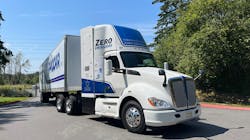Tucked away in the trees of northern Washington state is the Paccar technical center, where the manufacturer develops and tests some of its latest technologies. Kenworth executives invited me and some other journalists to the facility’s 1.6-mile test track last week to take some of their new electric trucks for a spin, no CDL required.
Full disclosure: As the newest member of the FleetOwner team, I had never driven any truck beyond a pickup. Class 8s are a world away from the Kia Rio subcompact I own, so I inferred one thing before ever stepping in the cab: Kenworth must have good safety tech.
Kenworth T680E
The first truck I drove was the T680E, the battery-electric version of Kenworth’s T680 diesel Class 8. I was immediately floored by how quiet it was, gliding along the track—except for an instant when I didn’t turn wide enough and ran some trailer wheels off the asphalt and into the gravel. When you drive an electric truck, you form a different relationship with the equipment as you hear sounds you wouldn’t have been able to with a diesel engine chugging underneath. Axles squeak and suspension bobs with every turn of the wheel, and you become especially in tune with the trailer’s movement as you listen to it behind you.
See also: Kenworth's electric future
Speaking with Kenworth’s executives, they said their production team spends extra time in development tweaking the truck to minimize those noises typically masked by a diesel engine. They also touted the benefits it will have for drivers not having to be shaken by loud, rumbling engines eight or more hours a day.
The T680E, which has a gross vehicle weight rating (GVWR) of 82,000 lb., was hauling a loaded trailer. At the time I drove it, it had a gross weight of about 70,0000 lb. That’s why I was shocked when the brakes, despite having to halt 35 tons, stopped on a dime. In fact, I had to stop myself from stopping too abruptly. The T680E’s regenerative braking has three levels that drivers can toggle through at the touch of a button to adjust to varying weather conditions or terrain.
Batteries are far and away the No. 1 factor in BEV range, said Andy Zehnder, Kenworth’s director of fleet sales—advanced technology and strategic accounts. Any company that makes bold claims about the range of their BEVs is likely doing so because they have installed a larger battery, not because they somehow designed a truck that is drastically more efficient or aerodynamic than the competition’s vehicle, he said.
The T680E is equipped with a 396 kWh battery pack that charges in three hours using a CCS1 port. That amount of electricity gives the truck a 150-mile range that, by Kenworth’s estimates, meets the needs of 20% of the market. That’s also enough electricity to power 10 homes for 24 hours.
TX-18 and TX-18 Pro
See also: Paccar TX-18, TX-18 Pro automated transmissions available for order
The TX-18 and TX-18 Pro are designed for heavy vocational applications, and while I didn’t exactly get to put them through the gauntlet while circling the track, the trucks were nevertheless shifting with ease as I hauled a 65,000-75,000 lb. gross weight.
T680 FCEV
It handled similarly to the T680E battery-electric. One main difference for the driver lies in the amount of noise. The motor of the T680 FCEV is situated much closer to the driver than in the T680E, resulting in a more noticeable series of whirring noises as I zipped up and down the track. While still quieter than a diesel truck, my focus lay more within the cab and what was immediately in front of me than on the trailer behind me as it did when I drove the T680E.
K270E
Common wisdom says it's a question of when, not if, electrification is coming. Kenworth certainly seems to see it as inevitable and is doing what it can to cover all bases.
About the Author
Scott Keith
Scott Keith is a former fleet owner digital editor, who was on staff from 2022 to 2023.




